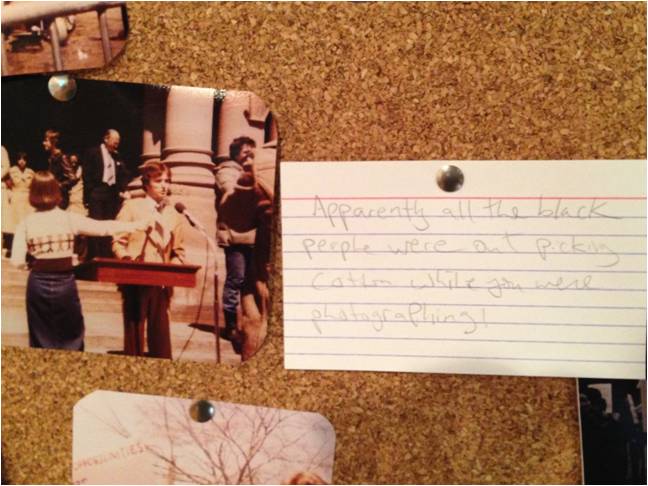
Censorship, Accident and Intervention at Gay Premises: Radical Voices in the Archives, 1973-1983 + 2013
Forty years after the politically and individually challenging period that was the subject of the Gay Premises exhibition, we have been challenged again by the unexpected and by censorship on our premises. In our gay premises, the gallery of The ArQuives, two incidents occurred recently, which require responses and invite further discussion. An artist’s work was damaged and a viewer’s comment card removed. In recounting the details here, I seek to provoke further dialogue and to express my regret, that as curator, I could not control or limit the damage. So with this, I seek to respond in a way that creates something productive from the acts of destruction.
The rendering by Eugenio Salas, a work in progress, was created as an intervention in to the space of Gay Premises. Part of TAG Team, Salas is participating in an ongoing questioning of the dominant narratives that underpin the archival materials used in the current exhibition. The piece was the first installment of a larger sound work that will bring recorded voices of those who are not present in the archival holdings of the 1970s. Voices from queer immigrants and refuges need insertion into the histories of queers in Canada, else we are in danger of repeating a closed and inequitable performance of completion. These histories are not over, nor safe, nor heard.
A second incident also raises questions about censorship and vulnerability. At the opening of the exhibition, I invited viewers to interact with the show by writing their thoughts and memories of events, people, etc. on cue cards. One card said:
“Apparently all the black people were out picking cotton while you were taking photographs”
This was placed on the Photograph Wall, which held photos of people at public demonstrations, celebrations, etc. Unlabelled, the photos show a variety of people – gay liberation, women’s lib, the socialist party, Marxists, etc. but no one of colour – working together for their overlapping causes of gay rights, human rights.
The cue card was removed sometime after the show. I tried to find out what happened but no one seems to know how or why the card is gone. I am personally disturbed by this act of censorship, and further alarmed that an act of censorship occurred in this space. Only queer or LGBTI+ and friends were in that space, so why did this happen? Why would someone in these communities commit this act of exclusion? Particularly upsetting, the act was intentional and covert.
So these two incidents raise questions for me as the curator: why did this happen? What are the implications? What next? Although I’ve investigated the ‘why,’ there seems to be no satisfactory answer. I deeply regret the damage to Salas’s piece, as it becomes not just an accident but can be seen as reinforcing a disregard for the missing voices. The gallery will continue to work with Eugenio Salas to find a way to turn this act of omission into an act of strength by looking at the larger issues of exclusion and voice in the archive.
I regret too that I can’t find the missing cue card, but we do have a photo. So we are reproducing that here. The image asks us to look back, look carefully and consider where we are in that challenge.
Karen Stanworth, Curator
